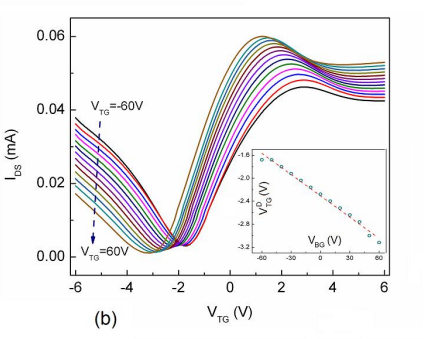How to Save the Troubled Graphene Transistor
The writing is on the wall for the silicon chip. Transistors have been shrinking for the last half a century but they cannot get smaller forever. Most industry pundits think that the downscaling of silicon chip technology cannot extend much beyond 2026. The big question, of course, is what will replace it.
One possibility is graphene, which various teams around the world have used to make hugely fast transistors. Last year, one team clocked a graphene transistor at a cool 427 GHz. So you could be forgiven for thinking that graphene is the perfect silicon replacement.
Not so fast. There is a significant problem with graphene that makes it difficult to use in transistors– it has no band gap.
That means there is no energy range in graphene in which electron states cannot exist. Or in other words, it’s impossible to switch off graphene. And for a transistor, that spells serious trouble.
Today, Guanxiong Liu and pals at University of California, Riverside, say they’ve found a way round this that allows graphene transistors with no band gap to work in an entirely different way to conventional switches. “The obtained results present a conceptual change in graphene research and indicate an alternative route for graphene’s applications in information processing,” they say.
Every solid material has its own characteristic bands of energy in which electrons can flow to form a conductor or are prevented from flowing to form an insulator. In a semiconductor, electrons cannot flow at low energy and so the material behaves as an insulator. However, a relatively small amount of energy can push electrons into the so-called conduction band where they flow freely forming a conductor.
The energy difference between these insulating and conducting states is the band gap and the ability to switch between one state and the other is the defining characteristic of transistor.
The problem with graphene is that it has no band gap; electrons can flow at any energy. So the major focus of graphene engineers has been to find ways of creating an artificial band gap using methods such as applying electric fields, doping with atoms or by stretching and squeezing the material.
These approaches have met with modest success. Practical digital circuits require a band gap on the order of 1 eV at room temperature. But the best efforts with graphene have produced modest band gaps in the few hundred meV.
Even then this has come at a serious cost. The best graphene transistors are hugely fast but they dissipate energy like there’s no tomorrow and leak current like water through a sieve.
Now Liu and co have come up with an entirely different approach. “We intentionally avoid any attempt to artificially induce an energy band, which would make graphene “more-silicon-like”, they say. Instead they rely on a different phenomenon called negative resistance to create transistor-like behaviour.
Negative resistance is the counterintuitive phenomenon in which a current entering a material causes the voltage across it to drop. Various groups, including this one at Riverside, have shown that graphene demonstrates negative resistance in certain circumstances.
Their idea is to take a standard graphene field-effect transistor and find the circumstances in which it demonstrates negative resistance (or negative differential resistance, as they call it). They then use the dip in voltage, like a kind of switch, to perform logic.
In fact, the main contribution of this paper is to show how several graphene field-effect transistors can be combined and manipulated in a way that produces conventional logic gates.
And the results are promising. Liu and co demonstrate the effectiveness of their approach by designing a graphene-based circuit that can match patterns and show that it has several important advantages over silicon-based versions.
For a start, Liu and co can build elementary XOR gates out of only three graphene field-effect transistors compared to the eight or more required using silicon. That translates into a significantly smaller area on a chip. What’s more, graphene transistors can operate at speeds of over 400 GHz.
All that translates into a system that dramatically outperforms silicon. They say the performance is “several orders of magnitude higher than for any reported or even projected scaled circuits.”
Of course, somebody will actually have to build and test these devices for real before this idea can gain widespread traction. But the Riverside team’s approach offers an unconventional and creative solution to a problem that has been giving graphene engineers sleepless nights for some time.
It’s just possible, that graphene’s negative resistance could give them the beauty sleep they so badly need.
Ref: arxiv.org/abs/1308.2931: Graphene-Based Non-Boolean Logic Circuits

Keep Reading
Most Popular
Large language models can do jaw-dropping things. But nobody knows exactly why.
And that's a problem. Figuring it out is one of the biggest scientific puzzles of our time and a crucial step towards controlling more powerful future models.
How scientists traced a mysterious covid case back to six toilets
When wastewater surveillance turns into a hunt for a single infected individual, the ethics get tricky.
The problem with plug-in hybrids? Their drivers.
Plug-in hybrids are often sold as a transition to EVs, but new data from Europe shows we’re still underestimating the emissions they produce.
Google DeepMind’s new generative model makes Super Mario–like games from scratch
Genie learns how to control games by watching hours and hours of video. It could help train next-gen robots too.
Stay connected
Get the latest updates from
MIT Technology Review
Discover special offers, top stories, upcoming events, and more.